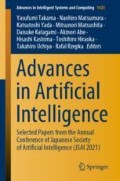Abstract
One of the reasons why stock prices fluctuate greatly is because of IR announcements, which are information for investors, and news reports on events that are closely related to the companies. When a stock price change occurs, news sites for investors may report the stock price change and the reason for the change. However, such articles report only a certain portion of overall events that are closely related to reasons for stock price changes. Thus, in order to provide investors with information on those reasons for stock price changes, it is necessary to develop a system to collect information on events that could be closely related to the stock price changes of certain companies from the Internet. As the first step towards developing such a system, this paper takes an approach of employing a BERT-based machine reading comprehension model, which extracts causes of stock price changes from news reports on stock price changes. Those extracted reasons are intended to be further used to train a system to collect information on events that could be closely related to the stock price changes of certain companies from the Internet.
Access this chapter
Tax calculation will be finalised at checkout
Purchases are for personal use only
Notes
- 1.
When evaluated with the SQuAD [14] (https://rajpurkar.github.io/SQuAD-explorer/).
- 2.
- 3.
Delivered from October 30th to December 3rd, 2020.
- 4.
As an alternative, we also examine the approach of using a single general question sentence such as below:
 However, this approach does not perform well in the evaluation compared with the case (a) in this section.
However, this approach does not perform well in the evaluation compared with the case (a) in this section. - 5.
- 6.
Trained with 104 languages, available from https://github.com/google-research/bert/blob/master/multilingual.md.
- 7.
http://taku910.github.io/mecab/ (in Japanese).
- 8.
- 9.
run_squad.py, with the number of epochs as 2, batch size as 8, and learning rate as 0.00003.
- 10.
http://www.cl.ecei.tohoku.ac.jp/rcqa/ (in Japanese).
- 11.
References
Becquin, G.: GBe at FinCausal 2020, task 2: span-based causality extraction for financial documents. In: Proceedings of 1st Joint Workshop on Financial Narrative Processing and MultiLing Financial Summarisation, pp. 40–44 (2020)
Chakravarthy, S., Kanakagiri, T., Radhakrishnan, K., Umapathy, A.: Domino at FinCausal 2020, task 1 and 2: causal extraction system. In: Proceedings of 1st Joint Workshop on Financial Narrative Processing and MultiLing Financial Summarisation, pp. 90–94 (2020)
Chen, D., Fisch, A., Weston, J., Bordes, A.: Reading Wikipedia to answer open-domain questions. In: Proceedings of 55th ACL, pp. 1870–1879 (2017)
Chen, T., Li, H., Kasamatsu, M., Utsuro, T., Kawada, Y.: Developing a how-to tip machine comprehension dataset and its evaluation in machine comprehension by BERT. In: Proceedings of 3rd FEVER, pp. 26–35 (2020)
Devlin, J., Chang, M.W., Lee, K., Toutanova, K.: BERT: pre-training of deep bidirectional Transformers for language understanding. In: Proceedings of NAACL-HLT, pp. 4171–4186 (2019)
Imoto, T., Ito, T.: JDD @ FinCausal 2020, task 2: financial document causality detection. In: Proceedings of 1st Joint Workshop on Financial Narrative Processing and MultiLing Financial Summarisation, pp. 50–54 (2020)
Ionescu, M., Avram, A.M., Dima, G.A., Cercel, D.C., Dascalu, M.: UPB at FinCausal-2020, tasks 1 & 2: causality analysis in financial documents using pretrained language models. In: Proceedings of 1st Joint Workshop on Financial Narrative Processing and MultiLing Financial Summarisation, pp. 55–59 (2020)
Kao, P.W., Chen, C.C., Huang, H.H., Chen, H.H.: NTUNLPL at FinCausal 2020, task 2: improving causality detection using Viterbi decoder. In: Proceedings of 1st Joint Workshop on Financial Narrative Processing and MultiLing Financial Summarisation, pp. 69–73 (2020)
Lee, K., Chang, M.W., Toutanova, K.: Latent retrieval for weakly supervised open domain question answering. In: Proceedings of 57th ACL, pp. 6086–6096 (2019)
Liu, Z., Huang, D., Huang, K., Li, Z., Zhao, J.: FinBERT: a pre-trained financial language representation model for financial text mining. In: Proceedings of 29th IJCAI, pp. 4513–4519 (2020)
Mariko, D., Abi-Akl, H., Labidurie, E., Durfort, S., De Mazancourt, H., El-Haj, M.: The financial document causality detection shared task (FinCausal 2020). In: Proceedings of 1st Joint Workshop on Financial Narrative Processing and MultiLing Financial Summarisation, pp. 23–32 (2020)
Özenir, G., Karadeniz İ.: ISIKUN at the FinCausal 2020: linguistically informed machine-learning approach for causality identification in financial documents. In: Proceedings of the 1st Joint Workshop on Financial Narrative Processing and MultiLing Financial Summarisation, pp. 85-89 (2020)
Pielka, M., et al.: Fraunhofer IAIS at FinCausal 2020, tasks 1 & 2: using ensemble methods and sequence tagging to detect causality in financial documents. In: Proceedings of 1st Joint Workshop on Financial Narrative Processing and MultiLing Financial Summarisation, pp. 64–68 (2020)
Pranav, R., Jian, Z., Konstantin, L., Percy, L.: SQuAD: 100,000+ questions for machine comprehension of text. In: Proceedings of EMNLP, pp. 2383–2392 (2016)
Sakai, H., Sakaji, H., Izumi, K., Matsui, H., Irie, K.: Extraction of causal and complementary information for generating market analysis comments by automatic generation of training data. In: Proceedings of 34th Annual Conference JSAI (2020). (in Japanese)
Szántó, Z., Berend, G.: ProsperAMnet at FinCausal 2020, task 1 & 2: modeling causality in financial texts using multi-headed transformers. In: Proceedings of 1st Joint Workshop on Financial Narrative Processing and MultiLing Financial Summarisation, pp. 80–84 (2020)
Author information
Authors and Affiliations
Corresponding author
Editor information
Editors and Affiliations
Rights and permissions
Copyright information
© 2022 The Author(s), under exclusive license to Springer Nature Switzerland AG
About this paper
Cite this paper
Suzuki, S., Tsutsumi, G., Utsuro, T. (2022). Machine Reading Comprehension of News on Stock Price Changes. In: Takama, Y., et al. Advances in Artificial Intelligence. JSAI 2021. Advances in Intelligent Systems and Computing, vol 1423. Springer, Cham. https://doi.org/10.1007/978-3-030-96451-1_1
Download citation
DOI: https://doi.org/10.1007/978-3-030-96451-1_1
Published:
Publisher Name: Springer, Cham
Print ISBN: 978-3-030-96450-4
Online ISBN: 978-3-030-96451-1
eBook Packages: Intelligent Technologies and RoboticsIntelligent Technologies and Robotics (R0)


 However, this approach does not perform well in the evaluation compared with the case (a) in this section.
However, this approach does not perform well in the evaluation compared with the case (a) in this section.